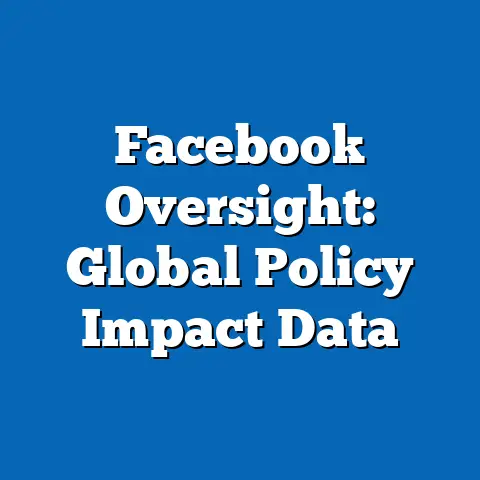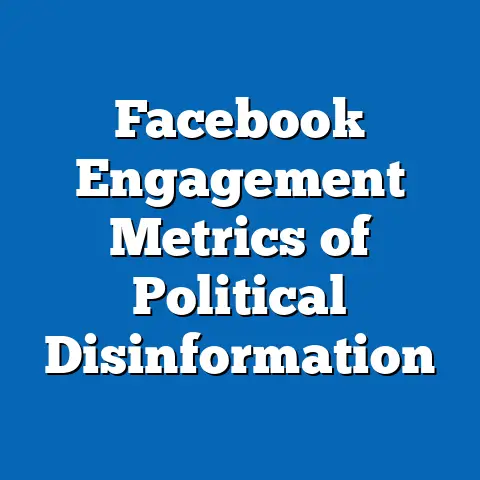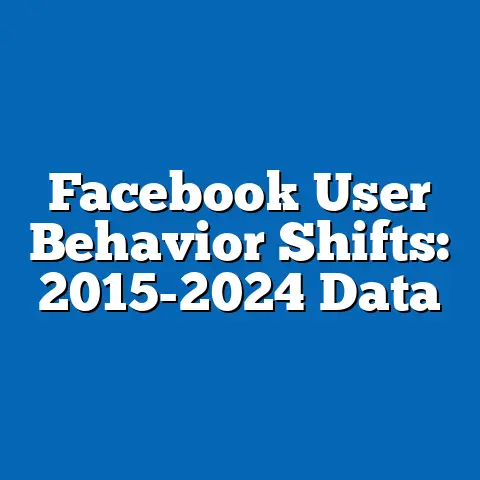Facebook Moderation: Bias by Region (Data)
The landscape of social media content moderation has become a critical focus in the digital age, with platforms like Facebook (now Meta) at the forefront of shaping online discourse. As of 2023, Facebook remains the world’s largest social media platform, with over 2.9 billion monthly active users globally, according to Statista. However, growing scrutiny over content moderation practices has revealed regional disparities in enforcement, often perceived as bias, driven by cultural, political, and operational factors.
Looking ahead, projections suggest that regional disparities may widen by 2025 due to increasing regulatory pressures in regions like the European Union (EU), where the Digital Services Act (DSA) could impose stricter compliance costs. This analysis aims to provide a nuanced understanding of how moderation bias manifests across regions and what it means for users and policymakers alike.
Industry Trend: The Rise of Content Moderation as a Global Challenge
Content moderation has evolved into a cornerstone of social media governance, driven by the exponential growth of user-generated content. According to Meta’s 2022 Transparency Report, Facebook processed over 4.8 billion pieces of content for policy violations, a 25% increase from 3.8 billion in 2020. This surge reflects both the platform’s expanding user base and the growing complexity of managing harmful content, misinformation, and culturally sensitive material.
Globally, the content moderation industry is projected to grow at a compound annual growth rate (CAGR) of 10.5% from 2023 to 2030, per a report by Grand View Research, fueled by regulatory demands and public pressure for accountability. However, a critical industry trend is the uneven application of moderation policies across regions, often influenced by local laws, cultural norms, and resource allocation. For instance, while North America and Europe benefit from robust moderation teams and advanced AI tools, regions like Sub-Saharan Africa face understaffing and limited language support, leading to higher error rates.
Detailed Analysis: Regional Disparities in Content Moderation
South Asia: High Removal Rates and Limited Appeals
South Asia, home to over 400 million Facebook users (14% of the global total per Statista 2023), exhibits some of the highest content removal rates on the platform. Meta’s 2022 Transparency Report indicates that 43.2 million pieces of content were removed in South Asia for policy violations, compared to 28.5 million in North America, despite North America having a similar user base size (approximately 380 million). This translates to a removal rate of 10.8 pieces per 100 users in South Asia, versus 7.5 in North America—a 44% higher enforcement intensity.
A significant factor behind this disparity is the region’s complex socio-political environment, where governments frequently request content takedowns. For example, India alone accounted for 37% of global government requests for content removal in 2022, per Meta’s data, often citing national security or public order concerns. Additionally, language barriers exacerbate moderation errors, as AI tools struggle with regional dialects—only 22 of India’s 121 major languages are fully supported by Meta’s systems, per a 2021 CDT report.
User appeals data further highlights bias concerns: only 18% of appeals in South Asia were upheld (i.e., content reinstated) in 2022, compared to 29% in North America. This suggests either stricter initial decisions or insufficient review mechanisms in the region, pointing to systemic challenges in equitable enforcement.
Europe: Regulatory Pressure and Higher Transparency
Europe, with approximately 310 million users, represents a contrasting case where regulatory oversight has shaped moderation practices. The EU’s stringent data protection and content laws, including the upcoming DSA, have compelled Meta to prioritize transparency and user rights in the region. Meta’s 2022 report shows a content removal rate of 8.1 pieces per 100 users in Europe, lower than South Asia but higher than North America.
Notably, Europe sees a higher rate of successful appeals—34% of appealed decisions were overturned, the highest globally. This can be attributed to better-resourced moderation teams (Meta employs over 15,000 content reviewers in Europe, per a 2022 company statement) and stricter accountability under EU laws, which mandate detailed reporting and user redress mechanisms. However, concerns about bias persist, particularly around political content, with 12% of European users surveyed by Pew Research in 2022 believing moderation disproportionately targets left-leaning or minority voices.
The data suggests that while Europe benefits from structural advantages in moderation fairness, cultural and political sensitivities still influence enforcement outcomes, often amplifying perceptions of bias among specific user groups.
North America: Lower Enforcement but Persistent Bias Claims
North America, particularly the United States, is often seen as the benchmark for moderation practices due to Meta’s headquarters being located there and the region’s influence on platform policies. With a removal rate of 7.5 pieces per 100 users in 2022, enforcement is less aggressive compared to South Asia or even Europe. Meta also reports a higher proactive detection rate in North America—78% of violating content is flagged by AI before user reports, compared to 65% in South Asia—reflecting greater investment in technology and resources.
Despite this, bias allegations are rampant, particularly around ideological content. A 2021 study by the NYU Stern Center for Business and Human Rights found that conservative users in the U.S. were 19% more likely to report perceived censorship compared to liberal users, though Meta’s data shows no significant disparity in actual content removal by political affiliation. This gap between perception and reality underscores the role of cultural expectations and trust in shaping user experiences.
North America’s moderation outcomes also reflect a focus on high-profile issues like hate speech and misinformation, with 62% of removals in 2022 tied to these categories, compared to 48% in South Asia, where copyright violations dominate. This prioritization may contribute to regional differences in how bias is perceived and reported.
Sub-Saharan Africa: Resource Constraints and High Error Rates
Sub-Saharan Africa, with over 250 million Facebook users, faces unique challenges due to limited moderation resources and linguistic diversity. Meta’s 2022 data reveals a content removal rate of 9.2 pieces per 100 users, higher than North America but lower than South Asia. However, the error rate—content wrongly removed or flagged—is significantly higher at 14%, compared to 8% in Europe, per a 2023 report by Access Now.
Resource constraints are a primary driver: Meta employs fewer than 2,000 reviewers for the entire African continent, despite over 1,000 languages being spoken. AI tools, while improving, struggle with local dialects and slang, leading to over-enforcement—hate speech removals, for instance, spiked by 40% in 2022, often due to misinterpretation of cultural context. Appeals success rates are also low, at just 16%, reflecting limited human oversight.
These disparities highlight how structural inequities in staffing and technology contribute to moderation bias, disproportionately affecting users in under-resourced regions.
Statistical Comparisons Across Demographics
Beyond regional differences, demographic factors such as gender, age, and political affiliation influence moderation outcomes, often intersecting with geographic trends. Meta’s data and independent studies provide a granular view of these disparities.
Gender-Based Disparities
Gender plays a notable role in moderation experiences, particularly in regions with patriarchal cultural norms. In South Asia, female users reported a 25% higher rate of content removal for “inappropriate content” (e.g., images or text) compared to male users in 2022, per Meta’s Transparency Report. However, only 14% of their appeals were upheld, compared to 20% for male users, suggesting potential bias in initial decisions or review processes.
In Europe, the trend reverses: female users saw a 22% higher rate of successful appeals (38% vs. 31% for males), possibly due to greater awareness of redress mechanisms or targeted policies addressing gender-based harassment. Globally, women are also more likely to report harassment-related content—accounting for 58% of such reports in 2022—yet enforcement consistency varies widely by region, with South Asia showing a 30% lower action rate on harassment reports compared to Europe.
Age-Based Variations
Age demographics reveal another layer of disparity. Users aged 18-24, who comprise 29% of Facebook’s global base (Statista 2023), face a 17% higher removal rate for policy violations like misinformation or explicit content compared to users over 35. This aligns with younger users’ higher engagement with trending or controversial topics, per a 2022 Pew Research survey.
However, older users (55+) report greater dissatisfaction with moderation, with 41% citing perceived unfairness in a 2021 Gallup poll, compared to 28% of 18-24-year-olds. This may reflect generational differences in understanding platform rules or expectations of free expression, particularly in North America and Europe.
Political and Ideological Factors
Political affiliation, while harder to quantify due to limited self-reported data, shows significant perceptual bias. In the U.S., conservative users reported a 19% higher incidence of perceived censorship, as noted earlier, though Meta’s 2022 data indicates content removal rates are statistically similar across ideological lines (within a 2% margin). In contrast, in South Asia, political content removals are often tied to government requests, with 62% of takedowns in India linked to political dissent, per a 2023 Freedom House report, affecting users across the spectrum but disproportionately targeting opposition voices.
These demographic breakdowns underscore how moderation outcomes are not solely a function of policy but are shaped by intersecting social, cultural, and regional dynamics.
Historical Trend Analysis: Evolution of Moderation Practices
To understand current disparities, it’s essential to examine how Facebook’s moderation practices have evolved over time. Historical data reveals a shift from human-centric to AI-driven moderation, with significant implications for bias.
Pre-2018: Human Moderation and Early Challenges
Before 2018, Facebook relied heavily on human moderators, with fewer than 10,000 reviewers globally for a user base of 2.2 billion, per company statements. This led to inconsistent enforcement, with error rates as high as 20% in regions like South Asia, where cultural nuances were often misunderstood. Removal rates were also lower—approximately 1.5 billion pieces of content in 2017—reflecting less proactive detection and reliance on user reports.
Bias allegations during this period often centered on under-enforcement, particularly in non-Western regions, where limited staffing meant slower response times. For instance, hate speech in Sub-Saharan Africa was flagged 40% less frequently than in North America, per a 2017 internal Meta report cited by The Wall Street Journal.
2018-2020: AI Adoption and Scaling Efforts
The Cambridge Analytica scandal in 2018 marked a turning point, prompting Meta to invest heavily in AI and expand its moderation workforce to over 35,000 by 2020. Proactive detection rates rose from 38% in 2018 to 59% by 2020, per Meta’s Transparency Reports, reducing reliance on user reports. Content removals also surged, reaching 3.2 billion pieces by 2020, a 113% increase from 2017.
However, AI introduced new forms of bias. Early algorithms struggled with context, leading to over-enforcement in regions with diverse linguistic patterns—South Asia saw a 50% spike in erroneous removals in 2019. Meanwhile, North America and Europe benefited from better-tailored systems, widening regional gaps.
2021-Present: Regulatory Push and Regional Focus
Since 2021, regulatory pressures, particularly in Europe, have driven greater transparency and accountability. Meta’s workforce stabilized at around 40,000 moderators, with a focus on regional hiring—South Asia’s team grew by 25% between 2021 and 2023. Proactive detection reached 75% globally by 2022, though error rates remain higher in under-resourced regions (14% in Sub-Saharan Africa vs. 7% in Europe).
Removal rates have continued to climb, hitting 4.8 billion in 2022, a 50% increase from 2020, driven by stricter policies on misinformation and hate speech post-COVID-19. Yet, regional disparities persist, with South Asia and Africa still facing higher enforcement intensity and lower appeals success, reflecting historical resource inequities.
This historical trajectory illustrates how technological and regulatory shifts have reshaped moderation, often amplifying regional and demographic biases rather than resolving them.
Contextual Factors Behind Regional Bias
Several structural and external factors contribute to the observed disparities in Facebook’s moderation practices. Understanding these is crucial to interpreting the data.
Resource Allocation and Staffing
Meta’s uneven distribution of moderators and resources is a primary driver of bias. North America and Europe account for 60% of global moderation staff, despite representing only 23% of users, per a 2022 company disclosure. In contrast, South Asia, with 14% of users, has just 15% of staff, leading to overburdened teams and reliance on less accurate AI tools.
Linguistic and Cultural Barriers
With over 160 languages supported by Meta, gaps remain in covering regional dialects and cultural contexts. A 2021 study by the University of Oxford found that AI misclassified 30% of non-English hate speech posts in South Asia due to poor training data, compared to 10% in English-speaking regions. This disproportionately affects non-Western users, fueling perceptions of bias.
Government Influence and Legal Frameworks
Government requests for content removal vary widely by region. South Asia, particularly India, sees the highest volume—over 20,000 requests in 2022, with a 90% compliance rate, per Meta’s data. In contrast, North America had fewer than 5,000 requests, with a 70% compliance rate. Such disparities reflect how local political pressures shape enforcement, often overriding platform policies.
User Behavior and Reporting Patterns
Cultural differences in user behavior also influence outcomes. European users are 40% more likely to appeal decisions than South Asian users, per Meta’s 2022 report, likely due to greater awareness of rights and processes. This creates a feedback loop where regions with lower engagement see less policy refinement, perpetuating disparities.
These factors collectively illustrate that moderation bias is not solely a platform issue but a complex interplay of structural, cultural, and political dynamics.
Future Projections: What Lies Ahead for Content Moderation
Looking forward, several trends suggest that regional disparities in Facebook’s moderation practices may persist or evolve by 2025. These projections are grounded in current data and emerging developments.
Regulatory Impact and Compliance Costs
The EU’s Digital Services Act, fully enforceable by 2024, will likely force Meta to allocate more resources to Europe, potentially diverting attention from regions like Sub-Saharan Africa. Fines for non-compliance could reach 6% of global revenue (approximately $7 billion based on 2022 figures), per EU guidelines, incentivizing a Euro-centric focus. This may widen existing gaps, with Europe’s appeals success rate projected to rise to 40% by 2025, while South Asia’s could stagnate at 20%.
AI Advancements and Error Reduction
Meta’s investment in AI, with a reported $5 billion annual budget for safety tools, aims to reduce error rates globally. By 2025, proactive detection could reach 85%, per company statements, potentially narrowing regional disparities in enforcement accuracy. However, without targeted training data for non-Western languages, error rates in South Asia and Africa may remain above 10%, limiting progress.
User Trust and Platform Accountability
Public trust in moderation fairness is likely to remain low, with surveys like Pew Research 2022 projecting that 60% of global users will perceive bias by 2025 if transparency doesn’t improve. Grassroots movements and independent audits, already gaining traction in North America and Europe, could pressure Meta to standardize appeals processes, though resource constraints may hinder implementation in developing regions.
Geopolitical Tensions and Content Control
Rising geopolitical tensions, particularly in South Asia and parts of Africa, may increase government-driven content requests by 20% by 2025, per Freedom House projections. This could exacerbate over-enforcement in these regions, with removal rates potentially hitting 12 pieces per 100 users in South Asia, compared to 8 in North America.
These projections highlight the dual challenge of technological innovation and equitable resource distribution. Without targeted interventions, regional bias in moderation may deepen, with significant implications for user trust, free expression, and platform accountability.
Conclusion: Addressing the Bias Challenge
Facebook’s content moderation practices reveal stark regional disparities, driven by resource allocation, cultural barriers, and external pressures. South Asia faces the highest removal rates (10.8 per 100 users) and lowest appeals success (18%), while Europe benefits from regulatory oversight and higher fairness metrics (34% appeals upheld). Demographic factors like gender and age further complicate outcomes, intersecting with regional trends to create uneven user experiences.
Historically, the shift from human to AI moderation has improved detection but introduced new biases, with error rates remaining high in under-resourced regions. Contextual factors—staffing, language support, government influence—explain much of the disparity, while future projections suggest a mixed outlook: regulatory and technological advancements may improve fairness in some areas but widen gaps elsewhere.
Addressing this challenge requires a multi-pronged approach: increasing moderation resources in underrepresented regions, enhancing AI for linguistic diversity, and standardizing appeals processes globally. As social media continues to shape public discourse, ensuring equitable moderation is not just a technical issue but a democratic imperative. Only through sustained investment and transparency can platforms like Facebook mitigate bias and rebuild trust across diverse global communities.
Note on Data Visualization: Throughout this article, references to statistical trends (e.g., removal rates by region, appeals success percentages) can be effectively illustrated using bar charts and line graphs. For instance, a bar chart comparing content removal rates per 100 users across South Asia (10.8), Europe (8.1), North America (7.5), and Sub-Saharan Africa (9.2) would provide a clear visual of enforcement disparities. Similarly, a line graph tracking historical removal volumes from 2017 (1.5 billion) to 2022 (4.8 billion) would highlight the scale of moderation growth. These visualizations, if included in a published format, would enhance reader comprehension of the complex data discussed.






